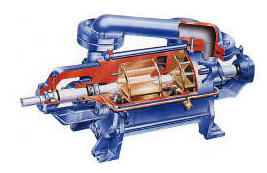Ring liquid vacuum pump

There's also a passage from the cone discharge to the discharge connection on the head. Some NASH pumps have a port plate configuration rather than conical, but the principle is the same. This diagram demonstrates what the rotor and body do while the pump is in operation. The spinning of blue liquid forms a ring due to centrifugal force.
Because the rotor axis and body axis are offset from each other, the liquid ring is not concentric with the rotor.
Air or gas traverses the internal passage to the cone inlet port. As the white dots indicate, the gas is drawn into the rotor chambers by the receding liquid ring, similar to the suction stroke of a piston in a cylinder.
The liquid ring does the job of pistons, while the rotor chambers play the part of cylinders. As each chamber rotates past the inlet port, the chamber carries a volume of air or gas around with it.
The white dots are confined between the cone and the ring of rotating liquid. The gas is compressed as the liquid ring converges with the cone. This represents the compression of air or gas from vacuum up to atmospheric pressure, or from atmospheric up to positive pressure in a liquid ring compressor.
When each chamber rotates to the discharge port opening, the compressed air or gas escapes from that chamber through the discharge port to the internal discharge passage. In this case, filtration systems are required to ensure that contamination is kept to acceptable levels. In non-recirculating systems, the discharged hot liquid usually water is treated as a waste stream.
In this case fresh cool water is used to make up the loss. Environmental considerations are making such "once-through" systems increasingly rare. These simple, but highly reliable pumps have a variety of industrial applications. They are used to maintain condenser vacuum on large steam-turbine generator sets by removing incondensable gasses, where vacuum levels are typically 30—50 mbar. They are used on paper machines to dewater the pulp slurry and to extract water from press felts.
Another application is the vacuum forming of molded paper-pulp products egg cartons and other packaging. Other applications include soil remediation, where contaminated ground water is drawn from wells by vacuum. In petroleum refining, vacuum distillation also makes use of liquid-ring vacuum pumps to provide the process vacuum. Liquid-ring compressors are often used in vapor recovery systems.
Liquid-ring vacuum pumps can use any liquid compatible with the process, provided it has the appropriate vapor pressure properties, as the sealant liquid. Although the most common sealant is water, almost any liquid can be used. The second most common is oil. Since oil has a very low vapor pressure, oil-sealed liquid-ring vacuum pumps are typically air-cooled.
For dry chlorine gas applications concentrated sulfuric acid is used. The ability to use any liquid allows the liquid-ring vacuum pump to be ideally suited for solvent vapor recovery. If a process, such as distillation or a vacuum dryer, is generating toluene vapors, for example, then it is possible to use toluene as the sealant, provided the cooling water is cold enough to keep the vapor pressure of the sealant liquid low enough to pull the desired vacuum.
Ionic liquids in liquid-ring vacuum pumps can lower the vacuum pressure from about 70 mbar to below 1 mbar. From Wikipedia, the free encyclopedia. Ionic liquids — designable materials for high-performing fluids. Retrieved from " https: Webarchive template wayback links. Views Read Edit View history. In other projects Wikimedia Commons. This page was last edited on 30 March , at By using this site, you agree to the Terms of Use and Privacy Policy.
Wikimedia Commons has media related to Liquid-ring pumps.